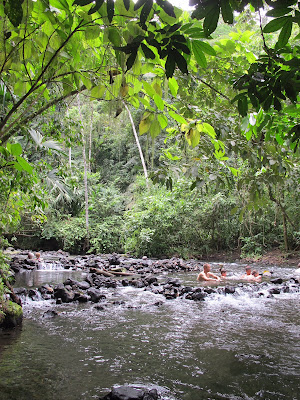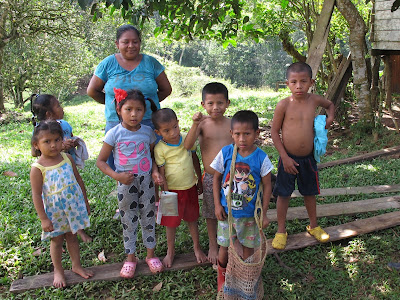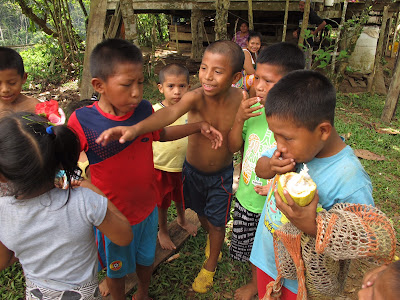Reflections on People from the Foot of a Volcano
Greetings from La Fortuna at the foot of Volcan Arenal. Until ten years ago, this volcano would regularly erupt every five minutes with a big boom and a cloud of smoke and fire. The dormant volcano started up suddenly in 1968 and remained active until 2010 when suddenly it stopped. The volcano was dormant for 450 years before 1968, so it’s unlikely to start up again any time soon.
The silence of the volcano is rued by travellers such as myself (it would have been a pretty sight!) and by about 10% of the locals. The 10% who own shares in the local hotel industry no doubt, since the end of the eruptions also meant the end of mass volcano tourism.
But most of the inhabitants of la Fortuna are pleased that the eruptions are over. One local told me that all through his childhood and youth the eruptions would take place every five minutes. And every time you had to be slightly on the lookout to make sure this was just a normal puff of smoke and fire and not a bigger eruption that you possibly had to evacuate from under. He told me he lived in a state of constant strain or slight stress. I can well imagine.
Apparently there was nothing dramatic about the ending of the eruptions. There was the usual eruption 5 minutes after the previous one, then suddenly... nothing. People were coming out into the streets to wonder what was going on - it was the talk of the town for days on end. Volcan Arenal just went back to sleep.
However the region still has much to offer. Nice views of the volcano of course
and the best birdlife I’ve seen to date! This, truly, would be a birdwatcher’s paradice.
Also there is a river running with warm thermal water, where locals and tourists alike go to take a refreshing dip.
But now onto something completely different. So far on this trip I’ve spent an unduly great amount of time on the topic of nature and animals and haven’t really touched on the topic of Panamanians and Costa Ricans (Ticos).
It’s obviously a bit arrogant to draw any conclusions about national identity from just a few weeks surjourn in a country, but that never stopped me before, so off we go.
Panamanians are just lovely. During an earlier trip (also covered in this blog), I gave highest grades to Colombians for friendliness. This characteristic seems to be shared by their neighbourging country’s inhabitants as well. Also, to my relief, the Spanish of Panama is as clearly articulated and easy to understand as that of Colombia.
A memorable meeting was in a village of indigenous people on my last day in Panama. We had chartered a private boat in Bocas del Toro to take us off the main island of Bocas and over to a local village on the island of San Cristobal.
This was clearly off track as a destination for travellers, so the people in the village looked at us with surprise, though not unkindly.
We walked to the end of the village where we met a woman and some children carrying planks from a pile of recycled woodstuff up a hill. We asked if we could help them, since we were going the same way anyway. The offer was accepted and off we went carrying our flotsam and jetsam.
We finally arrived at the lady’s house, which she told us housed 20 people (and a pig). Most of the inhabitants were kids, all of whom seemed very young.
The lady offered us refreshments - first some local fruit that they called guava, but was unlike the guava fruit I know - this was some seeds in a dry pod. You sucked the sweet fruit meat off the seeds. They she asked if we would like to taste some cocoa beans. Two kids ran off in a state of excitement and returned with the cocoa pods, which they opened by banging them against a tree. The method for trying the fruit was the same as with the guava - you sucked the white flesh off the hard cocoa beans. A tangy and sweet taste, unexpected, fresh and good, but totally unlike the taste of chocolate. I took one seed and offered the pod to the children asking if they would like some as well. Would they ever! The speed at which those 10-or-so kids managed to go through the two pods was impressive. Cocoa is a cash crop and this was a poor family - so I don’t think the children got this kind of cocoa treat too often.
Unfortunately our boat driver was waiting so we couldn’t take up her neighbour on her offer to introduce us to her home as well. But this brief meeting was one of the more cherished ones I had in Panama. When travelling, most of the people you meet are in the service industry. It’s seldom that you share a moment with local people such as the one we shared with these farmers. That’s one of the reasons I like using public transport. For a fleeting moment at least you are in the company of regular locals and having some slight interaction with them - rather than interacting only with waiters and hotel receptionists and taxi drivers.
On crossing over to Costa Rica the first thing that struck me was that I suddenly stopped understanding Spanish. Ticos have explained to me that the Spanish of their country is very bad (their words, not mine) and that they usually abbreviate words leaving out key parts (such as half the word) - and also, somewhat surprisingly, incorporate a lot of English words in their speech.
English here is more widely spoken than in Panama, and so enthusiastic are English-speaking Ticos to practice, that when you ask them something in Spanish, they are more than likely to answer in English. (I suddenly start to sympathize with expats trying to learn Finnish in Helsinki, where people will immediately switch to English if you so much as slightly mispronouce a word).
There is a strangely ”Americanized” feeling to Costa Rica - and by Americanized here, I mean the US. But for the language and the nature and a few other details, it somewhat feels like Costa Rica could be a state in the US. This is the country to come to if you want to experience Central America for beginners: safe, organized, familiar.
People are friendly enough, I cannot say a bad word. Yet somehow I feel more drawn to the people of Panama. Costa Rica seems to have adopted some traits from the US that don’t appeal to me. Things such as branding. The best example is ”Pura Vida”.
The internet tells us:”Pura Vida! Costa Rica Lifestyle. ... Simply translated, it means “simple life” or “pure life”, but here in Costa Rica, it is more than just a saying—it is a way of life. Costa Ricans (Ticos) use this term to say hello, to say goodbye, to say everything's great, to say everything's cool.”
I’m somewhat put off by things like wanting to define the Costa Rican ”lifestyle”, wanting things to be ”cool” - even branding yourself as Ticos rather than Costa Ricans. I wonder how much they paid the marketing agency...
And boy oh boy have the Ticos bought into this Pura Vida cult! I defy you to find a T-shirt or tourist trinket without a Pura Vida text. There are Pura Vida signs in parks and on cafe walls and randomly anywhere you can think of to stick a text. And if you run out of wall, nail it on a palm tree why don’t you?
But my aim is not to give the place too bad a rap. I must say I’ve met lovely people here too.
And not just people. As I’ve mentioned in previous entries, the wildlife here in Costa Rica is incredible.
Talking of which, the strangest thing happened today. As some of you may know, my only fobia has to do with our eight-legged friends. As a confirmed arachnophobic, it may then sound very odd that I found myself cooing in very motherly tones over a Costa Rican orange-kneed tarantula today! It seems my fobia is very distinct and aimed at those daddy longlegs kind of spiders, with streamlined bodies and long legs on which they can run like the wind. More chubby spiders with short legs are easier, though no treat. But a tarantula now. Why they’re just the cutest little buddies! Though I think the nice coloration helped. This guy was like two hard boiled egg yolks covered in black velvet with colourful furry stubby little legs. And note, he had TEN legs! Some may call the foremost legs feelers or antlers, but legs they clearly are and therefore tarantulas are not spiders and therefore I don’t need to be scared of them. End of. But you can still shut your eyes if you don’t want to see the photo:
This particular chap (I’ll call him Harry) was walking along in the most unlikely place - a big dirt car park. A group of adoring papparazzi-tourists ringed him as he made his majestic and slow way right across the 50 metre carpark. Just as Harry finally reached the jungle on the other side, he changed his mind and started his equally majestic and slow way back to the jungle he had originally come from. Maybe this crossing of the giant carpark is some initiation rite of young males of the species and Harry’s buddies were cheering him on in the background.
As I cheer you all on! And fear not fellow arachnophobics, I promise faithfully never to have another image of a spider on this blog.
More mountains on the horizon as I travel on.
More mountains on the horizon as I travel on.





















Comments